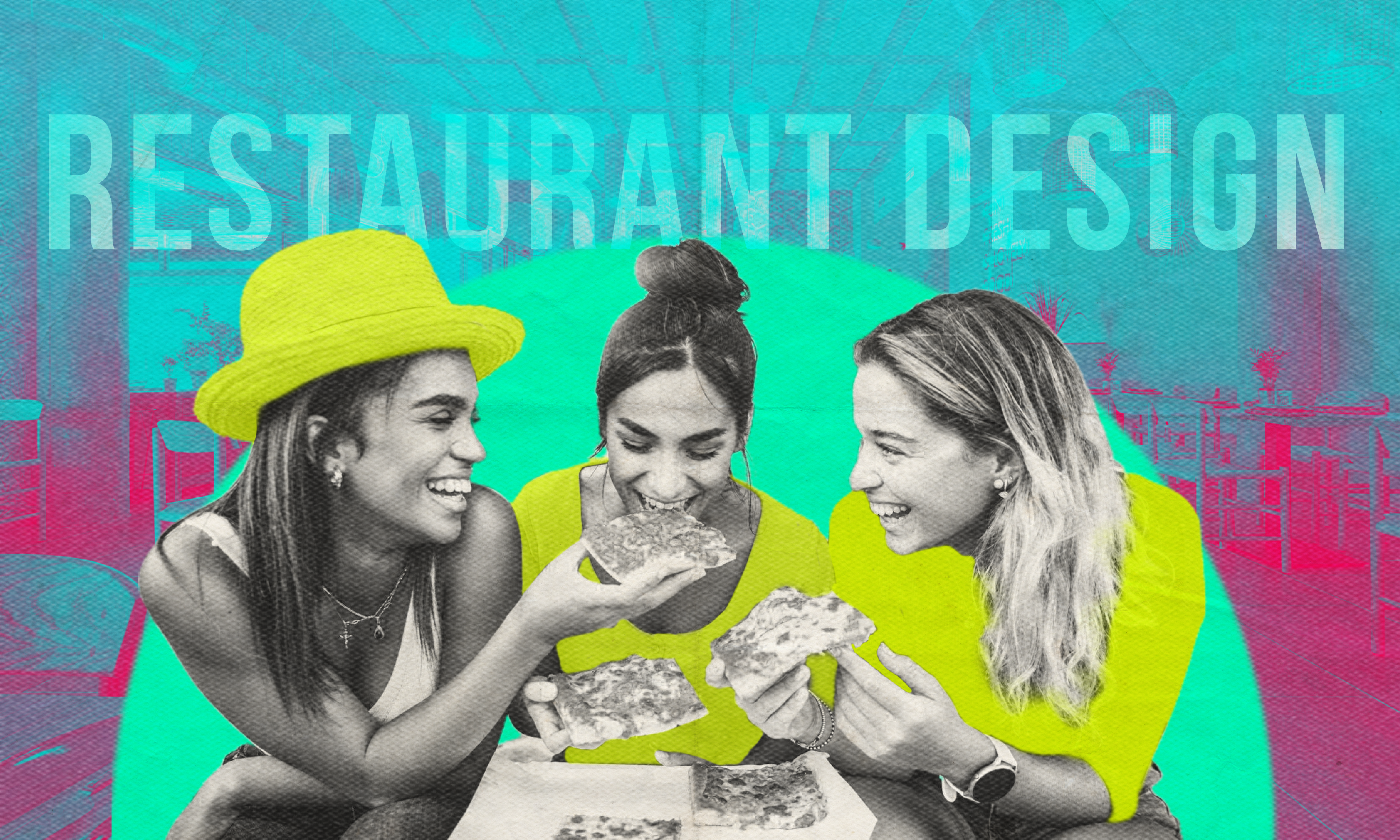Designs are complicated stories narrated in a simple visual and textual language.
An ideal restaurant design impacts the customer’s experience as much as the delicacy on the plate does. A well-thought design concept adds value to the surroundings, from the layout to the table setting and the choice of music to the menu style. Every component affects how people place their orders and how often they visit.
Restaurants that use an accurate theme, balanced colour composition, symmetrical spacing of seating area, curated typography, and aesthetical artwork creates a perfect ambience for an unforgettable dining experience.
The most appealing elements of any restaurant design are:
- Suave architecture
- Ambient lighting
- Warm colours that stimulate hunger and calmness
- Alluring scent of food
- Fitting themes
- Soothing acoustics
A combination of these exudes a pleasant vibe.
Design experts know how to tell a story through their art. The selection of décor, seating capacity, the ratio of the spacing between lights, the wall art, and the alignment of the drinks bar convey the message of a happy meal. These might sound simple to consumers, but each section influences the customer’s psychology.
For instance, fast-food joints have compact seating, and dine-in restaurants have comfortable spaces because the former wants you to leave quickly and the latter wants you to linger longer.
To explain, when you visit McDonald’s, you might notice that while the chairs are comfortable, they are not cosy enough to sit all day. However, if you go to an exquisite dinner place, there are sofas and cushion chairs to ensure customers stay longer and enjoy a fulfilling experience.
We understand the importance of perfectly blending the design elements of shape, size, texture, space, colour, and art to create an impactful brand image of the restaurant. Our design strategy focuses on creating the best design concepts for restaurant spaces using techniques that leave a lasting impression.
Restaurant Design Concepts that are Truly Stunning
Restaurant design has to be as tempting as the food to connect with customers and stand out as a brand. Let’s look at nine fascinating restaurant design concepts that take your eatery to the next level:
1. Fast-Food Concept
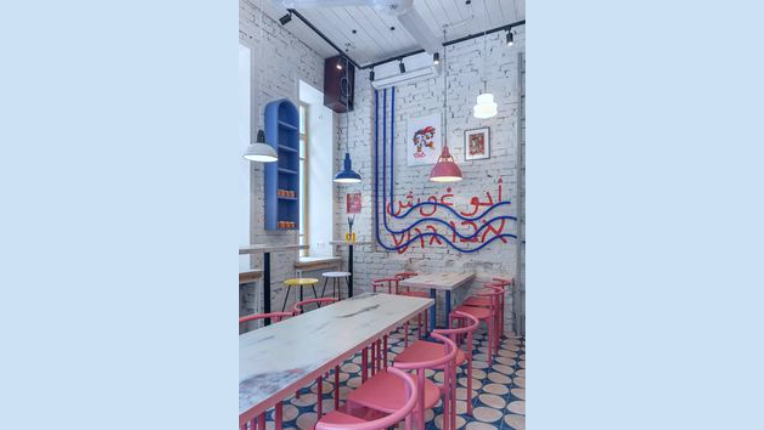
Cafés and fast-food restaurants are known for cosy spaces and chic layouts. Expert restaurant designers know how to weave a tale with their artwork.
Observe this design, especially the beautiful colour contrast of pink and white that reminisces customers of milkshakes and doughnuts. You will imagine the taste with your senses and then savour it with your taste buds. It’s simply inviting on a breakfast morning!
The partially natural lighting elevates the customer’s senses and makes them happy. Coupled with colourful accent lights for decor, white and blue radiate warmth to create a delightful restaurant experience. The spacing of lights is done in an optimal proportion to give out a calm ambience to the diners.
Observe how the long, spacious table can serve many customers in minimal space. People can eat in groups in a close-knit atmosphere, and there are high tables near the window for someone who prefers to have their coffee or work while listening to tunes and looking at the scenery in a quiet corner.
Above this, the blue cupboard can be used for books or magazines to attract readers or store a sample of different items sold on the menu to inform visitors. The flawless walls with graffiti can convey a positive affirmation to the customers. Overall, it combines all the design elements for a heart-warming vibe and serves all kinds of customers.
Bonus Read: Scroll through our collection of the 7 best food ad design examples.
2. Fast Casual Restaurant
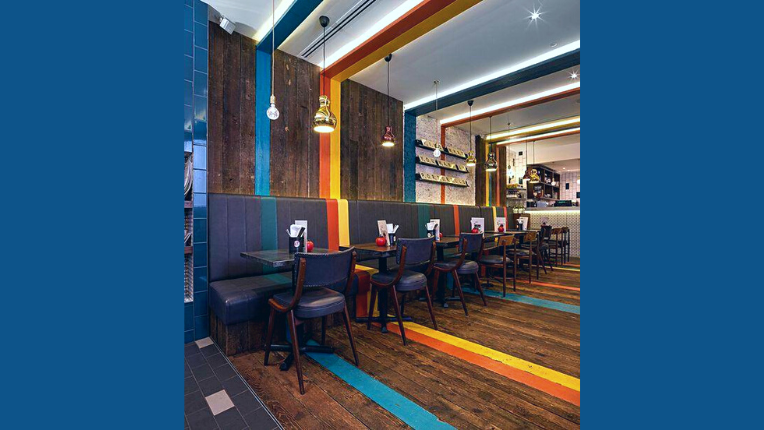
Restaurant designs combining different colour textures to give a fine-dining appearance are charming.
The symmetrical layout of this design gives an organised look, enticing visitors for a relaxing meal. Look at the blend of yellow and red, which heightens appetite. Furthermore, the brown colour depicts cheerful friendliness and sophistication to the customers. The blue adds to the aesthetics, while the black seating looks regal.
The designers have incorporated ambient lighting with task lights to create a warm experience. The best part is the accessibility of the ordering area and comfortable and capacious seating, making it easy for the servers to move.
Observe how the intimate seating alignment provides smooth manoeuvring, and the dummy fruit conveys the implicit message of healthy food. Even better, the floor-to-ceiling colour saturation is brilliant and pleasing to the eyes.
The designers have paid attention to the target customers who prefer dining out in small open spaces with soulful music, which is a major element to consider in any eatery design concept.
We love how the overall design is compact and in perfect proportion. It does not overwhelm the visitors but has a welcoming vibe. Food-lovers would make it a regular spot and visit again.
3. Fine Dining Restaurant
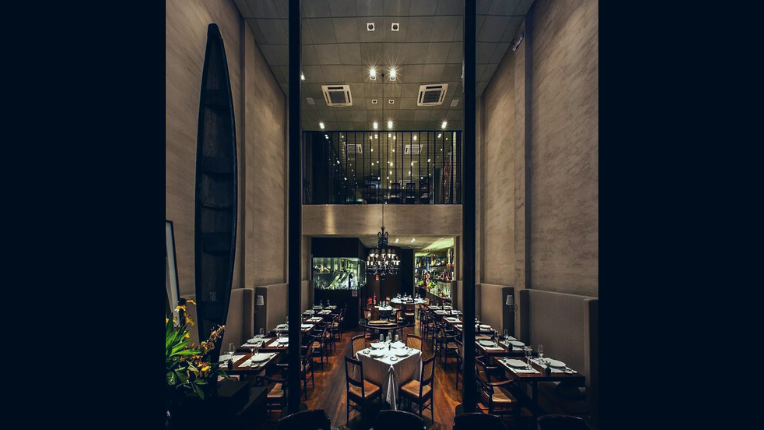
Fine dining restaurants are elegantly appealing. Design experts work on them with precision and accuracy to bring essential design aspects to the fore. They are known as great dining places that serve food with refined plating, occasionally offering piano music in the background.
This design of Attica in Melbourne is famous for its gorgeous interiors. The layout is typically formal with modern aesthetics, looking satisfying to the eyes. Interestingly, the dazzling lights and hanging lamps create a subtle fusion between different shades of illuminating lamps.
It’s simple yet voguish; the food feels palatable under such warm lighting. Note that fine dining restaurants avoid extra bright lighting fixtures and prefer a lighter hue of yellow or blue lights because they want to create a lighting balance for various customers. This makes it easier for visitors to skim through the menu, the staff to navigate, and the décor lights to resonate with the interiors.
The designers have gone to the extent of the seating arrangement being aligned in proportion with the air conditioners for a quiet dining affair. Above all, the repetition of different shades of brown contrasts sharply with the grey background, and the smooth texture of the surface balance all the visual elements of the restaurant design.
While the wooden theme gives a vintage vibe to the visitors, the drinks bar is visible at the corner while eating, so customers will buy a drink even if they initially did not plan to drink one. Also, the perfect shape of lamps, tables, seating chairs, and the ratio of space between each of them add desirable proximity to the final look.
It’s professional yet cosy, targeting customers who prefer sleek settings and formal dinners.
Talk to our design experts to learn more about different restaurant design concepts.
4. Typography Concept

Cafes, pizzerias, and burger joints that serve light meals, snacks and beverages prefer typography design concepts because it’s hip, vibing with young customers who love street food and a variety of thirst-quenching beverages.
Design experts apply advanced graphic and typography techniques to create a unique brand identity for this type of restaurant design. Though they occupy smaller spaces, larger crowds are attracted.
Examine how the mix and match of colours are in sync with the food and stylish text fonts with witty messages look modern and attractive. Customers can spend time reading and admiring the graphics while placing their orders.
The typeface is aligned in a hierarchical order and follows a combination of a letterform. Thus, the words and images create a delightful art on the wall that looks appealing to the eyes and blends effortlessly with the food and drinks.
The font choice and quirky message on the walls, entrance, and menus are entertaining and connect with customer emotions while conveying a strong brand image.
Popular brands like Starbucks, Burger King, and Coffee Roasters use typography techniques powerfully to impact customer psychology towards their brand.
Typography themes have a lasting effect. So that the next time a customer looks at a similar font face, it immediately reminds them of the restaurant’s brand image – increasing brand recall rates. Remember, carefully curated typography designs are essential for the success of this design concept.
Bonus Read: Our design masterminds at 55knots have curated a list of stunning coffee shop fonts for hipster logos and labels.
5. Modern Minimalist
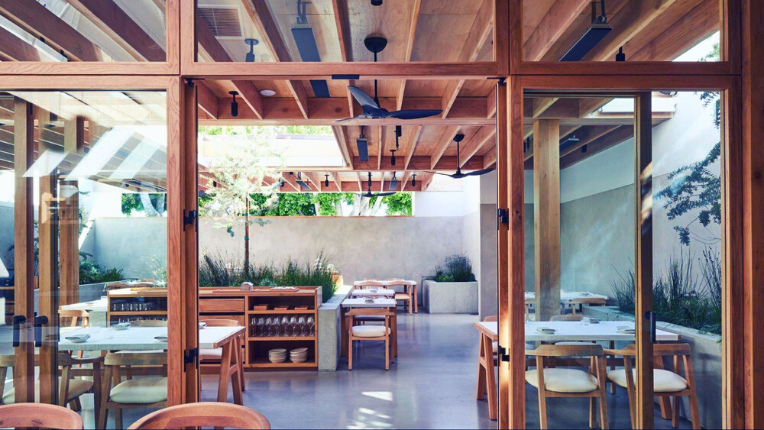
Minimalist designs are plain yet classy. The simplicity, elegance, and posh vibe characterise its features and radiate a serene feeling while calming all our senses. You might forget the taste of food over time, but you will remember how you felt at that moment in the restaurant.
Minimalist layouts are in trend due to the spreading of the minimalism concept where you eliminate inessential items and keep only the necessary ones.
Design experts curate modern minimalist looks using a combination of monochromatic colours. Usually, light colours and maximum natural lighting awaken our senses and lighten the mood.
This design concept uses the mirror illusion technique to create a sense of more open space in an industrial-style architecture. It’s beautiful how the inner and outer mirror walls and the plants surrounding leave a sense of natural warmth.
Additionally, the glass partition allows privacy for diners, and they reflect the light such that it dances inside the interiors, looking amusing to the eyes. On a slightly intellectual note – people widely believe that mirrors illuminate our light and symbolise wisdom and truth.
The blend of different elements is not noticeable. Hence, it shows how designs are an intricate merger of shape, size, texture, and spacing.
6. Barbeque Restaurant Design
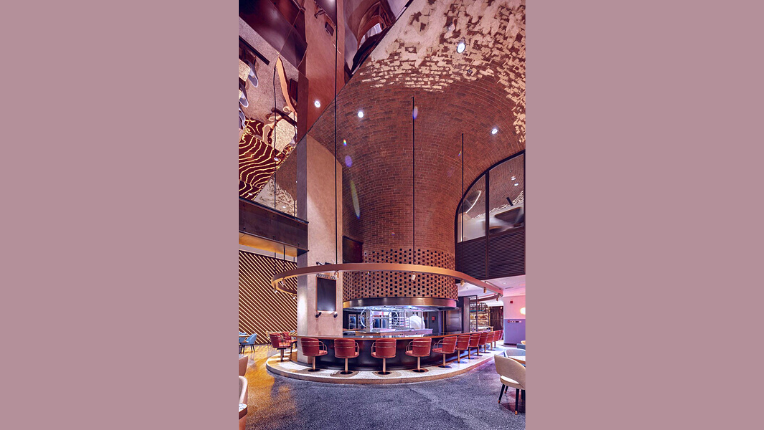
Barbeque (BBQ) restaurant formats are thoughtfully chosen for a personalised customer experience.
Barbeque Nation Atmosfire in Dubai is the best example of a picturesque design. This restaurant has a central fire-pit serving six different delectable grills, and the brick brazier structure from floor to ceiling is bewildering, allowing such dining destinations to amaze anyone.
The futuristic architecture, variety in the menu, hospitable colours, the shape of the bricks, acoustics, and the texture of different colours – each detail is meticulously crafted.
The restaurant designers have done a fantastic job with the display. One cannot help but turn curious about every attribute, which is the sign of a customer-centric diner.
The idea behind the central fire-pit is to let customers socialise when they devour a luxurious meal. It emanates a personal touch with the dining experience, which is crucial to restaurant brand-building methods.
7. Garden Restaurant Concept
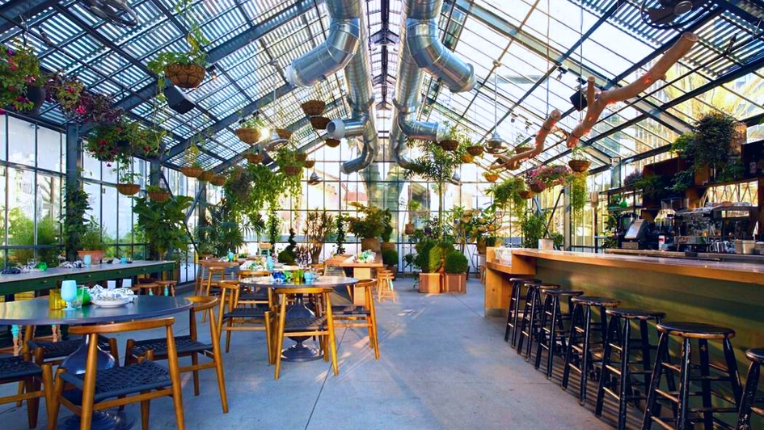
Garden designs have a unique advantage of producing natural scents to enhance customer senses. However, the plant selection is pivotal to the holistic layout of the restaurant.
Furthermore, the seeping of natural sunlight creates an organic effect making you feel cosy and relaxing. Since the greenery purifies the air and looks visually welcoming, visitors are almost guaranteed a soothing atmosphere.
Firstly, the alignment of a combination of herbs and shrubs with a few hanging pots is an effective strategy to project the restaurant theme.
Secondly, the menu should consist of plant-based items alongside other dishes.
Lastly, music that is neither too high nor too low works best in a garden setting. Customers should feel connected to the concept because they flock to green restaurants to enjoy the feel of nature, eat light snacks, and experience the outcome of organic meals – all amid nature-centric surroundings. Hence, every element should depict the organic concept of the restaurant design.
8. The Classic Concept
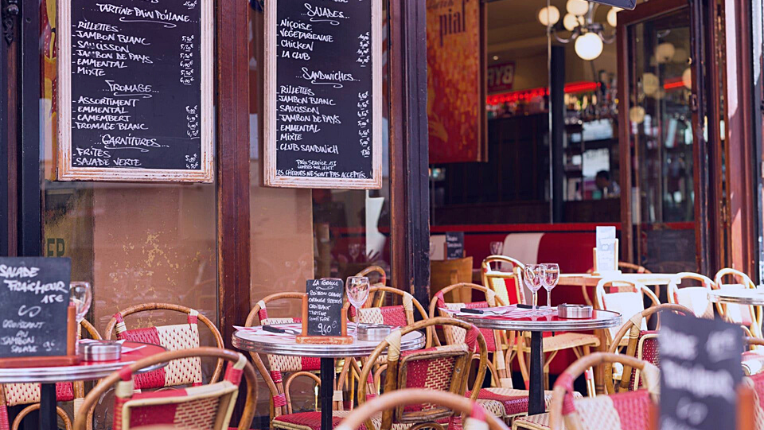
Classic concepts transport the diners to the good old days. When vintage cars ran on the roads, Elvis Presley and the Beatles were a new trend, and restaurants were the best socialising space.
Design experts use old themes, high-resolution photographs, and retro graphics, combining dull colours to create a classic effect on our senses. They bank on depicting an atmosphere that no longer exists. Keep in mind, the vibe matters a lot to convince customers to visit.
The archetype menu with various items fusing the old and modern eras and an affectionate seating area to make people feel a part of the design are quintessential elements in any classic-themed restaurant.
These design concepts represent old-school classiness and require using geometric shapes, immaculate features, appealing lighting, an impactful entrance, and a USP dish to emerge as a successful and inviting option for the customers.
Narrating a befitting tale, these designs sell the experience of a time to create a memorable dining episode in a bygone era.
We have designs that transcend time. Visit our site to choose a fascinating design tool for your business.
9. Pop-Up Design Concept
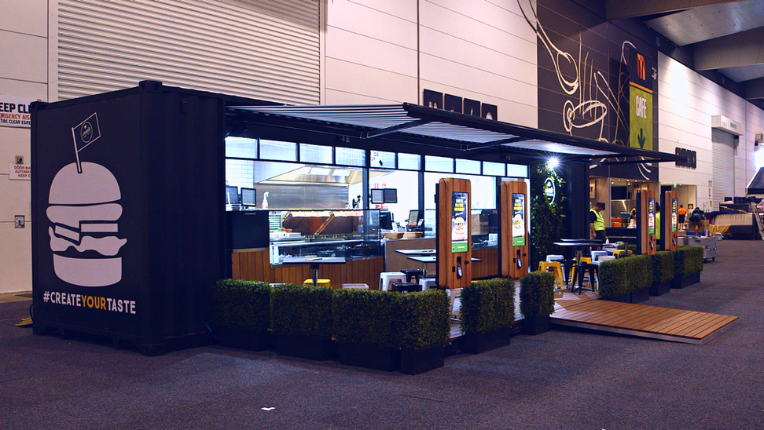
Pop-up restaurant designs are poignant, captivating and temporary. Designers apply basic design elements to create stylish decor that resonates with the straightforward menu items of pop-up setups.
As the name suggests, they pop up for a short time, entertain customers with their food, and pack up to shift places and spread their brand awareness. These restaurants usually operate in makeshift spaces, food trucks, or already existing eateries.
Graphics and typography are essential components for branding pop-ups and attracting customers.
The spicy, quirky scent of the food is appetising, and you can’t resist but taste the food.
Pop-up concepts have been popular since the 1960s. They follow a simple business model and effortless layouts to provide a relaxing and warm eating experience. It’s a perfect example of blending a few elements like colour, lights, typography, and graphics to deliver a remarkable pop-up affair.
Verdict
A compelling design is instrumental in communicating the brand’s message. Restaurants are revamping to rebrand themselves using the latest design techniques because customers are no longer there for tasty food but for mindful aesthetics and mood-specific settings.
If you’re seeking the guidance of expert graphic, interior, or outdoor designers, let’s chat.
